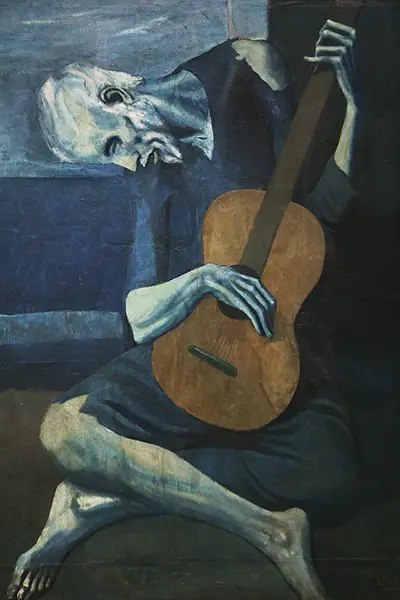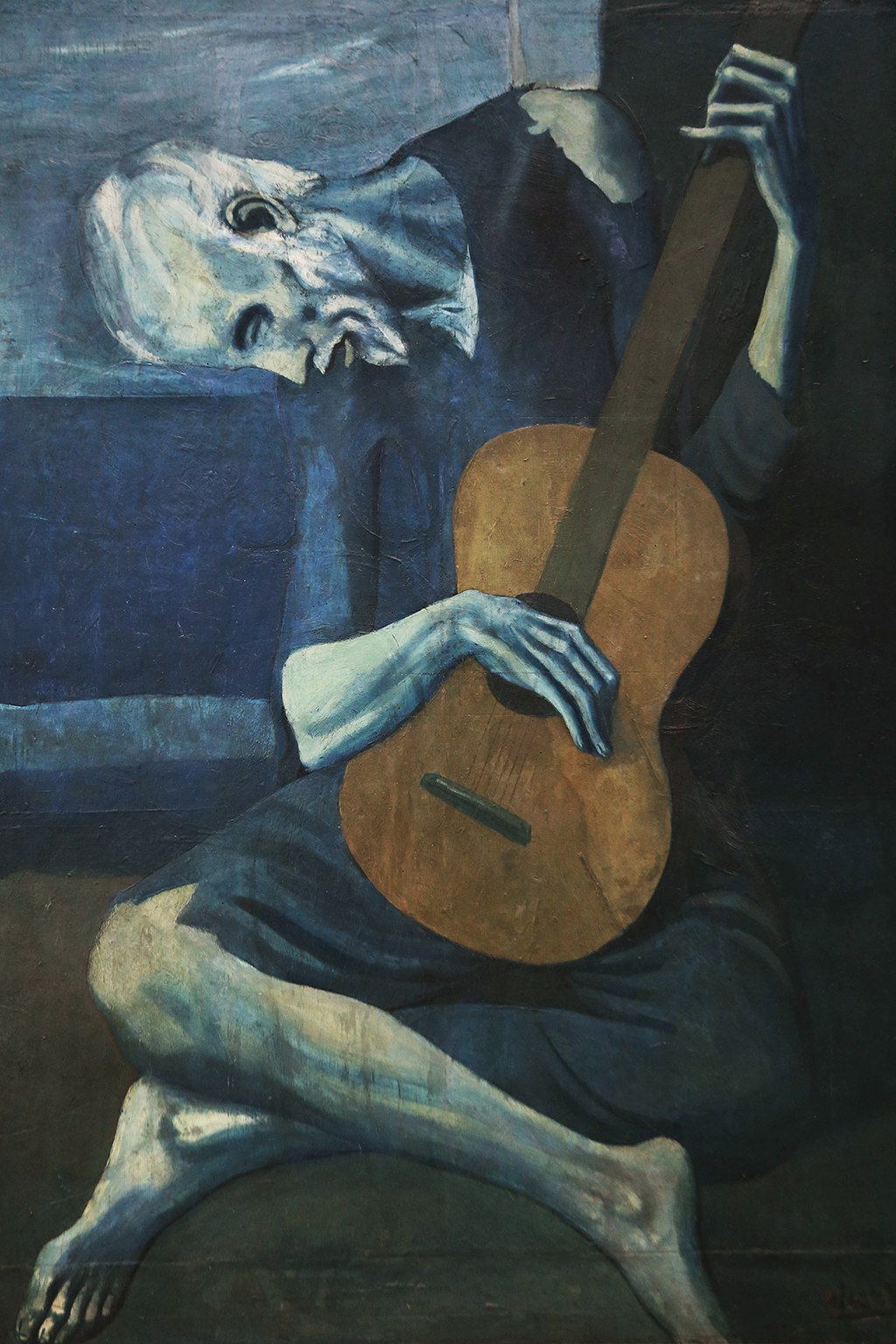Pablo Picasso was an artist who felt a connection with those struggling in society, in a similar way to artist Van Gogh, whose early works included The Potato Eaters. The Old Guitarist is one of a number of Picasso portraits which aim to draw attention to the plight of the poor, the ill and others struggling in the society of the day. This particular artwork captures an elderly blind man leaning over his guitar. His poverty is underlined by his worn clothing and how he is playing in the streets of Barcelona, Spain to provide money for food. The painting was created in Madrid in 1903. It was around that time that Picasso's close friend, Casagemas killed himself and this incident was to leave its mark on a young Pablo. The Old Guitarist is a significant contribution to his Blue Period, a spell of several years where his work was mainly themed with melancholic tones of blue.
As Van Gogh had moved to France and begun to experiment with colour in the bright southern countryside, Picasso would also move on from his own sombre period several decades later. This particular painting came in the very early 20th century and it was around this time that Pablo himself had been struggling financially. This strengthened his understanding of the problems being suffered by others. Artist El Greco is known to have been an influence on some of the earlier work of Picasso, and that is evident here, with the twisted torso used in this portrait. Recent research have uncovered several un-finished paintings below the Old Guitarist, and elements of them can be seen with the naked eye in areas of the background. The habit of re-using canvases is common for artists and there have frequently been new works found to be lurking underneath other completed paintings, across most art movements. It is possible that one of the portraits covered by the final artwork was one of Picasso's many Weeping Woman portraits, although that has never been confirmed.
Music appears in this painting to distract the blind man from his disability and poverty, with his guitar taking a large literal and symbolic role in the artwork's composition. There is a solemn look to the guitarist as he slouches over his musical instrument. This suggests significant problems in his life, as he struggles to make ends meet. There is also an elongation of form in order to accentuate the symbolism used by artist Picasso. This technique was common in the work of Greek painter, El Greco, of whom Pablo was very much acquainted. The composition and colour scheme aim to isolate the figure, further underlining his loneliness and vulnerability in the world. Picasso aimed to draw attention not to this specific individual, but the problems of poverty more generally. This artwork uses colour to signify the importance of the old man's guitar - it is his lifeblood and only true hope for survival at this point.
The browns of this guitar stand out against the rest of the canvas which is relatively subdued. Some have argued that the old man is purely a representation of the artist himself, essentially living a solitary life due to the implications of being an artist. It also points to his reliance on society to keep him afloat. There have also been some discussion as to whether the composition and style of this artwork was inspired by George Frederic Watts's painting of Hope in 1886. The similarities are clear, but it is unknown as to whether Picasso was ever actually exposed to this painting. Picasso was someone who drew on all of his emotions for his work, both positive and negative. He actually seemed to produce his best work when using the most extreme emotions, such as horror with his series on the Spanish Civil War, as shown with Guernica and The Weeping Woman. He would also cover his animals that brought him so much joy throughout his life, and also the women with whom he shared lively and exciting affairs.
Picasso was a highly accomplished artist who was taught well in the traditional methods. Early on in his career he also followed these styles before starting to form an approach of his own. He was therefore more than able to add an effective use of perspective to his paintings, but in this case chose to flatten the perspective which was common within 20th century art. It was as if we had gone full circle back to the periods before the Renaissance, when the same lack of perspective was common. The various modern art movements which appeared during Picasso's lifetime were all about bending reality, where a new perspective, essentially, was created. This was exciting and fresh, but many critics saw it as rejecting the principles of art and encouraging a lower quality of painting. In actual fact, this was artists taking things onwards once more, just as various Renaissance artists had done by developing perspective within art in the first place.
"They said, 'You have a blue guitar, you do not play things as they are.' The man replied, 'Things as they are, are changed upon the blue guitar.'"
Walter Stevens (As a metaphor for the need to immerse oneself fully in one's grief in order to heal)
Vulnerability is a key theme in this artwork, with this elderly man looking downwards with a sadness that represents his perilous position. The colour scheme uses various tones of blue, in the main, and this continues to build on an atmosphere of melancholy. The brighter touches of white paint are mainly added to his hair and beard, which increases his age and plays again on the difficuly position in which he is forced to rely on others for support. The musical aspect is also important because artists for many centuries have focused on this pastime in order to achieve different impacts within their work. In this case it represents a desperate attempt for survival whilst in other cases it can represent entertainment and groups enjoying themselves together, or perhaps the amusement of monarchies. The visual aspect helps us to learn more about the types of instruments used across the centuries, and within different European nations. Cubist artists would make use of the instruments themselves for still life compositions, but Old Guitarist was not a part of Picasso's contribution to that movement.
Traditionally, European art would not devote much time to the poorer elements of society, as it would be considered by some as unattractive and also not suitable for the fine arts. Instead, many would concentrate on the rich and famous, such as the monarchies or successful merchants. These would always offer the best commission values, but without the freedom of expression that artists demand today. Picasso was part of the new breed who were able to work without the involvement or interference of patrons, focusing of whatever content and style that he wanted. This allowed him to forge multiple phases of work, where he worked collaboratively with others to add new ideas. This way of working is much more popular today, as variety is very much in demand. This has allowed whole new movements to appear as well as a greater focus on international art within European art institutions, perhaps attempting to reflect the growing number of migrant communities within their respective populations, as well as also embracing female artists in a fairer way than was seen before.
This painting from 1903-1904 can now be found at the Art Institute of Chicago in the USA. Their selection of 46 original Monet paintings is perhaps the headline grabbing element to their overall collection that runs into the many thousands. They also have non-European art and antiquities as well, such as a variety of African and Asian items which will interest historians as much as art fans. So, much to see here, and this institution can be considered amongst the most impressive and important venues in the entire US and perfectly represents the diverse nature of Chicago's population. Cliff Walk at Pourville, On the Bank of the Seine, Bennecourt and The Artist's House at Argenteuil are amongst the best Monet works to be found here and you can also find other notable Europeans included here such as Albrecht Durer and Georgia O'Keeffe, representing the eclectic nature of their permanent collection.
The majority of Picasso's work remains in Europe, spread between France, Spain and the UK in most cases. In recent generations there has been a continued dispersal of European art across to the US as well as other regions such as Asia and the Middle East. Many now see art as an investment opportunity, whilst others believe that high profile names can draw in additional tourists to their major cities. As a side note, it can also aid local art students when they are able to study these pieces in person, which is always a much better way of learning than simply by reading about these famous paintings or looking at photographs of them online. This is particularly the case with the Renaissance and Baroque masters, who would use very subtle techniques which could never be understood other than by seeing these items in person. In the case of more modern artists, it would be the emotion and expression of ideas that became more important, even though most were capable in painting in traditional styles, if they chose to.
Those looking to see more of this artist's best work should also check out the likes of Les Demoiselles d'Avignon, Girl Before a Mirror and Garcon a la Pipe. This was an artist who tackled all manner of different styles within his career, even contributing to the conception of certain movements, such as Cubism. He was also diverse in the type of mediums that he used, being a highly skilled draughtsman as well as designing many ceramics as well. He never lost his creative drive and wanted to take it down as many avenues of expression as possible. He also liked to draw in all manner of different influences into his work, with the African styles being well documented. Nature and the animal world would also create an impact, such as through his portraits of some of his pets and these continue to be amongst the most popular Picasso prints, offering charming pictures of all manner of different creatures which are accessible to even the most occasional art fan. He also became known for his single line drawings, which most of us would be entirely incapable of producing from our own minds.



